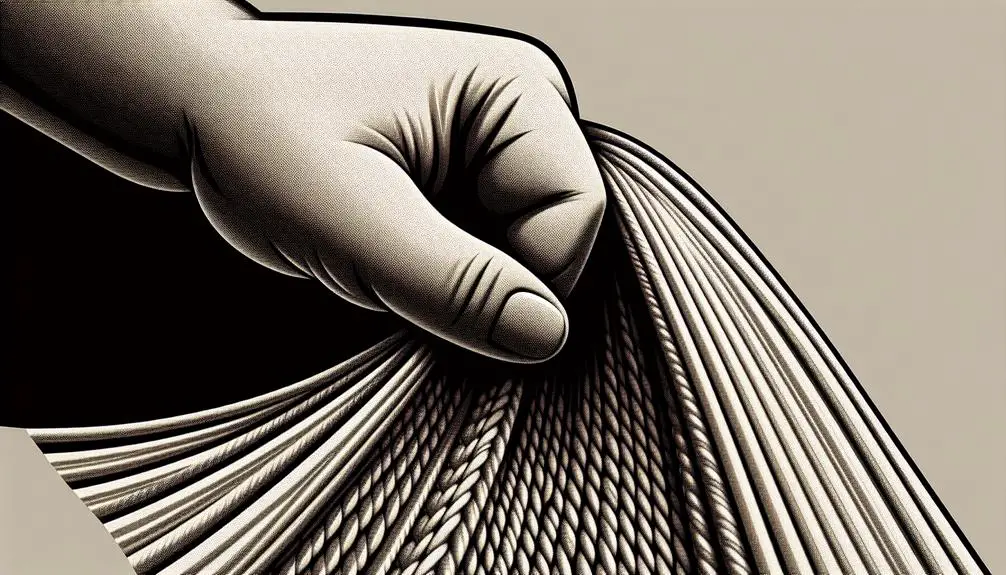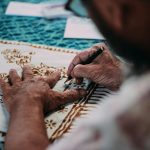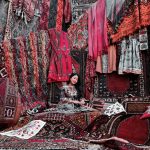So, did you know that duck canvas gets its name from the Dutch word 'doek,' meaning cloth?
This sturdy fabric has been around for centuries and has stood the test of time for a reason. But what exactly makes duck canvas so special, and why is it a go-to choice for many practical projects and industries?
Let's unravel the mystery behind this versatile material and explore its fascinating characteristics and uses together.
Table of Contents
Key Takeaways
- Duck canvas is a tightly woven fabric known for durability in heavy-duty applications.
- It comes in various weights, weaves, and colors for versatility in different projects.
- Primarily made from cotton, duck canvas offers exceptional strength and tear resistance.
- Widely used in military, outdoor gear, workwear, and DIY projects for its durability and strength.
Origins of Duck Canvas
Duck canvas traces its origins back to its Dutch predecessor, known as 'doek,' which originally denoted a sturdy linen cloth favored for its durability and strength. The term 'duck' in canvas refers to the tightly woven, plain weave fabric that provides robustness and sturdiness. Initially used for sailcloth due to its resilience, duck canvas has transitioned from its maritime heritage to become a versatile material employed in various sectors like fashion, home decor, and industrial applications. While early versions were crafted from linen, modern duck canvas predominantly consists of cotton fibers, blending strength with flexibility for diverse projects.
The evolution of duck canvas showcases its enduring popularity in heavy-duty tasks, ensuring longevity and dependability across a range of uses. From its humble beginnings as sailcloth to its modern-day presence in a myriad of applications, duck canvas continues to be celebrated for its durability and tight weave, making it a go-to choice for projects requiring reliability and endurance.
Characteristics of Duck Canvas
Originating from sturdy linen cloth known as 'doek' in Dutch, duck canvas embodies a robust woven fabric made predominantly from cotton, celebrated for its exceptional strength and resistance to tears and abrasions. When exploring the characteristics of duck canvas, several key features stand out:
- Durability: Duck canvas is renowned for its durability, making it a popular choice for heavy-duty applications where strength is essential.
- Variety: This canvas fabric comes in various weights and colors, offering versatility for different projects and preferences.
- Weave Options: Different weave patterns such as plain weave, twill weave, and herringbone weave are available, each providing unique textures and visual appeal to the fabric.
Understanding these characteristics can help you appreciate the versatility and strength that duck canvas brings to a wide range of applications.
Common Uses of Duck Canvas
With its exceptional strength and versatility, duck canvas finds widespread use in a variety of practical applications. Duck fabric is commonly employed in creating durable bags, totes, and backpacks due to its robust nature, making it ideal for everyday use that requires reliability.
Additionally, its sturdiness makes duck canvas a popular choice for upholstery, such as chair covers and cushions, where longevity is essential.
Outdoor enthusiasts appreciate duck fabric for crafting items like tents, awnings, and camping gear due to its water-resistant properties, ensuring a dry and comfortable outdoor experience. DIY enthusiasts often turn to duck canvas for projects like aprons, tool belts, and storage bins, benefiting from its resilience and durability in various settings.
Moreover, workwear and uniforms frequently feature duck canvas fabric, as it can endure heavy-duty use and harsh conditions, providing long-lasting performance and comfort for those who rely on it daily.
Different Types of Duck Canvas
When it comes to duck canvas, understanding the different types is essential. Canvas weave types and fabric weight variations play a crucial role in determining the suitability of the canvas for specific projects.
Let's explore the nuances of these variations to help you choose the right duck canvas for your next endeavor.
Canvas Weave Types
Duck canvas comes in various weave types, each offering unique characteristics and suitability for different projects.
- Plain Weave: This common type features a simple over-under pattern, providing a sturdy surface ideal for painting or crafting.
- Twill Weave: With a diagonal rib pattern, twill weave duck canvas offers added texture and flexibility, making it perfect for garments, bags, and upholstery.
- Herringbone Weave: The V-shaped pattern of herringbone weave duck canvas adds visual interest and strength, making it great for decorative and durable projects.
Choosing the right weave type is crucial as it impacts the appearance, texture, and strength of the canvas, ensuring that your projects turn out just the way you envision them.
Fabric Weight Variations
Exploring the diverse fabric weight variations of duck canvas reveals a spectrum of options tailored to specific project needs and durability requirements. Cotton canvas weight ranges from 7 to 32 oz per square yard, with lighter options (7-12 oz) offering more pliability for projects like tablecloths and bags.
On the other end, heavier weights (over 15 oz) are preferred for heavy-duty applications such as industrial covers and outdoor equipment. Numbered duck canvas employs a classification system where higher numbers denote heavier fabrics suitable for robust projects.
Selecting the appropriate duck canvas weight is crucial to ensure optimal durability and performance across various endeavors, aligning the fabric choice with the intended use.
Single Filled Cotton Duck
Single filled cotton duck is a lightweight fabric that is loosely woven in the oxford style. It's perfect for projects that need a softer touch and more flexibility.
This fabric is a popular choice for items like clothing, tote bags, and lightweight upholstery. Its soft texture and breathable nature make it comfortable to wear and easy to work with.
Fabric Characteristics
Lightweight and loosely woven in the oxford style, single filled cotton duck fabric offers a softer feel compared to heavier weight duck canvas. When it comes to fabric characteristics, single filled cotton duck stands out for its unique properties:
- Lightweight Construction: Single filled cotton duck is known for its lightness, making it ideal for projects requiring a softer touch.
- Loose Weave: The looser weave of this fabric provides a more pliable texture, perfect for creating items that need flexibility.
- Soft Feel: Unlike heavier duck canvas, single filled cotton duck offers a gentle and comfortable feel, making it a popular choice for various crafting projects that demand a lighter weight fabric with some pliability.
Common Uses
For those seeking a softer touch and more pliability in their projects, single filled cotton duck fabric is a versatile choice, commonly utilized in crafting items like liners, tablecloths, and bags.
This lightweight duck cloth, woven in the oxford style, comes in various weights such as 7, 10, and 12 ounces per square yard. Its softer feel compared to heavier options makes it ideal for projects requiring a gentler touch.
Whether you're making a custom tablecloth for a special occasion or crafting a durable bag for everyday use, single filled cotton duck fabric offers the versatility and flexibility needed.
Embracing this fabric opens up a world of possibilities for creating functional yet stylish pieces that stand out with their softness and pliability.
Numbered Cotton Duck Canvas
Utilizing plied yarns, numbered cotton duck canvas offers a range of weights from 12 to 32 oz per square yard, each weight corresponding to a specific project requirement. This classification system simplifies the selection process, ensuring the right canvas for the job. Here's what you need to know about numbered duck cloth:
- Weight Varieties: The numbered cotton duck canvas comes in a range of weights, allowing for versatility in choosing the right fabric for your specific project needs.
- Durability and Texture: Known for its firm texture and durability, numbered duck cloth is a reliable choice for heavy-duty applications where strength is crucial.
- Suitability for Various Projects: Whether you're working on a lighter project that requires a softer touch or a heavy-duty task demanding robust material, the varied weights of numbered cotton duck canvas cater to a wide array of project requirements.
Understanding the intricacies of numbered cotton duck canvas empowers you to select the perfect fabric for your next creation.
Army Cotton Duck Cloth
Coming from the realm of heavy-duty fabrics like numbered cotton duck canvas, Army cotton duck cloth stands out as a rugged and durable material extensively utilized in military applications and outdoor gear. This canvas is renowned for its exceptional strength and resistance to tears and abrasions, making it an ideal choice for rugged uses.
Available in various weights, the higher weights indicate increased durability and sturdiness, ensuring longevity in challenging conditions. The tight weave of Army cotton duck cloth not only provides excellent water resistance but also enhances its overall durability.
This fabric is commonly employed in crafting military uniforms, tents, backpacks, and other heavy-duty gear due to its reliability and robust nature. Whether facing harsh weather or demanding terrains, Army cotton duck cloth proves to be a dependable and long-lasting material, making it a staple in military and outdoor gear applications.
Belting Cotton Duck Fabric
I'll kick off our discussion by highlighting the practical uses of belting cotton duck fabric, emphasizing its incredible durability and strength.
We'll explore how this fabric is commonly employed in various industrial applications, showcasing its reliability in demanding conditions.
Get ready to discover the versatility and resilience of belting cotton duck fabric in a range of common applications!
Uses of Duck Fabric
Belting cotton duck fabric, known for its exceptional durability and resistance to abrasion, is commonly utilized in heavy-duty applications such as belts, straps, and industrial covers. When considering the uses of duck fabric, belting cotton duck stands out for its versatility and strength. Here are three key applications where this fabric shines:
- Industrial Belts: Due to its high tensile strength and rugged construction, belting cotton duck fabric is a popular choice for manufacturing industrial belts that need to withstand heavy loads and constant use.
- Heavy-Duty Bags: The durability and water-resistant properties of belting cotton duck make it an excellent material for crafting sturdy and long-lasting heavy-duty bags, ideal for outdoor adventures and rugged environments.
- Outdoor Gear: From backpacks to tent covers, belting cotton duck fabric is favored in the production of outdoor gear that requires resilience against wear and tear in challenging conditions.
Durability and Strength
With its reputation for exceptional strength and durability, belting cotton duck fabric is a go-to choice for heavy-duty applications that demand resilience and longevity. This tightly woven fabric is resistant to abrasions and tears, making it ideal for projects requiring robust and long-lasting material. In addition to its durability, belting cotton duck fabric offers water-resistant properties, ensuring suitability for outdoor and rugged environments. Here is a breakdown of the key features of belting cotton duck fabric:
| Feature | Description | Benefit |
|---|---|---|
| Strength | Exceptionally strong material | Ensures longevity and resilience |
| Durability | Resistant to abrasions and tears | Ideal for heavy-duty applications |
| Water-Resistant | Protects against moisture | Suitable for outdoor environments |
Common Applications
Frequently utilized in industrial settings, belting cotton duck fabric serves a wide range of common applications due to its exceptional strength and durability.
- Conveyor Belts: Belting cotton duck fabric is commonly used in the manufacturing of conveyor belts due to its ability to withstand heavy loads and constant movement.
- Heavy-Duty Straps: This type of duck fabric is ideal for making heavy-duty straps that are used in securing goods, equipment, and machinery in industrial environments.
- Harnesses: Belting cotton duck fabric is also commonly employed in the production of harnesses for safety equipment, providing reliable support and durability yard after yard.
Hose Cotton Duck Cloth
Crafted from a sturdy cotton weave, hose cotton duck cloth stands out for its exceptional water-resistant properties, making it a top choice for various applications requiring protection against moisture. This type of cotton duck cloth is commonly used in making hoses, outdoor equipment covers, and other items that need to withstand water exposure. The durability and strength of hose cotton duck cloth make it a reliable option for outdoor and industrial use, where resilience to water is essential. Its water-resistant nature not only enhances longevity but also boosts performance in challenging environments. These unique characteristics elevate hose cotton duck cloth as a preferred material for projects where water resistance is a crucial factor.
| Characteristics | Benefits |
|---|---|
| Water-resistant | Protection against moisture |
| Durable & strong | Reliable for outdoor & industrial use |
| Longevity & performance | Enhanced performance in tough conditions |
| Preferred material | Key requirement for water resistance |
Enameling Cotton Duck Cloth
Hose cotton duck cloth, known for its exceptional water-resistant properties, transforms into a versatile material suitable for various applications when subjected to enameling, a process that enhances its durability and aesthetic appeal. Enameling cotton duck cloth involves applying a thin layer of enamel or paint to the fabric, enhancing its durability, making it more resistant to wear and tear. This enameling process can also add a glossy or matte finish to the cotton duck cloth, depending on the desired look.
Enameling adds durability to the fabric.
It can provide a glossy or matte finish.
Enameling enhances the water-resistant properties of the cotton duck cloth.
Enameling cotton duck cloth is commonly used in creating custom bags, accessories, and home decor items. The process provides not only aesthetic value but also functional benefits, making the fabric more versatile for a range of projects.
Selecting the Right Duck Canvas
When selecting the right duck canvas for your project, consider factors such as weight, specific types, width variations, texture, and historical or modern styles to ensure the best fit for your needs. The weight of the canvas is crucial, ranging from lightweight 7oz options suitable for lighter projects to heavy-duty 15oz choices for more durable applications. Look for specific types like belting cotton duck for heavy-duty tasks or biscuit cotton duck for quilting projects, each offering unique characteristics tailored to different needs. Checking the width variations is essential, as duck canvas comes in sizes ranging from 22' to 150', ensuring you have the right dimensions for your intended use.
Evaluate the texture and durability of numbered cotton duck cloth, which uses plied yarns and comes in various weights measured by an industry-standard numbering system, ranging from 12 to 32 oz/square yard. Additionally, exploring historical and modern styles such as army, belting, and numbered varieties can help you find the best fit for your specific project requirements.
Frequently Asked Questions
What Is the Difference Between Regular Canvas and Duck Canvas?
Regular canvas and duck canvas differ in their weave tightness. Duck canvas has a tighter weave, enhancing durability and tear resistance. Consider the project's demands to choose between them wisely. It's like picking the right tool for the job.
What Do You Use Duck Canvas For?
I use duck canvas for crafting sturdy bags, creating durable upholstery, making outdoor equipment like tents, and painting. Its strength, water resistance, and firm texture make it perfect for a variety of projects that require durability and reliability.
Is Duck Canvas Waterproof?
I'll share some insights on duck canvas and its waterproof capabilities. Treatments like waxing or coating can enhance water resistance. However, prolonged exposure to moisture might lead to absorption. Proper care is crucial.
Why Is It Called Duck Canvas?
Called duck canvas due to its tight weave, offering durability and strength. The term 'duck' reflects the fabric's robust nature, perfect for rugged projects. It's not about the bird but the sturdy, water-resistant material.
- Where to Buy Sherpa Suede Fabric - July 12, 2025
- How to Draw or Illustrate the Texture of Suede Fabric - July 12, 2025
- What Is Baseball Suede Leather Fabric? - July 12, 2025




